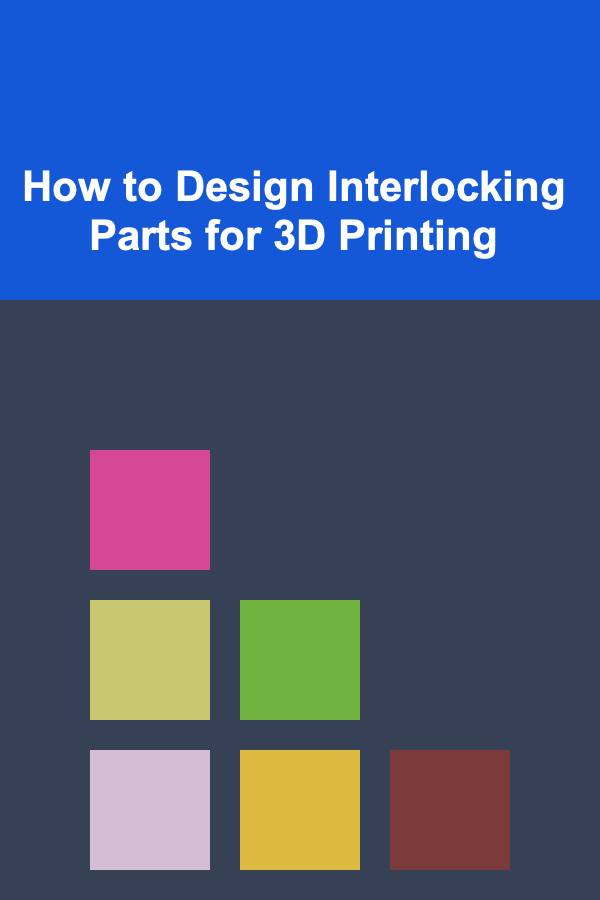
How to Design Interlocking Parts for 3D Printing
ebook include PDF & Audio bundle (Micro Guide)
$12.99$10.99
Limited Time Offer! Order within the next:

Designing interlocking parts for 3D printing is a unique and highly rewarding challenge that combines mechanical design principles with the advantages and constraints of 3D printing technology. The ability to create parts that interlock seamlessly allows for complex assemblies to be printed as separate pieces and then joined together without the need for additional hardware, such as screws or adhesives. This technique is widely used in product design, prototyping, and even in creating intricate mechanical systems or art pieces.
However, designing parts that fit together in a precise and functional way requires careful planning and understanding of both 3D modeling and the specific characteristics of 3D printing. In this article, we will explore the essential principles, tips, and techniques for designing interlocking parts for 3D printing, as well as common mistakes to avoid.
Understanding the Basics of Interlocking Parts
Interlocking parts are components that fit together, often in a mechanical or puzzle-like fashion, without the need for external fasteners. These parts can range from simple snap-fit designs, where one part locks into another, to more complex systems, such as gears, hinges, or enclosures. The key to designing successful interlocking parts is ensuring that the parts are both precise and functional in their interlocking action.
There are several fundamental factors to consider when designing interlocking parts for 3D printing:
- Tolerance: 3D printing is inherently less precise than traditional manufacturing methods. The accuracy of printed parts can vary depending on the printer, material, and layer height. Designing parts with appropriate clearances (tolerances) is essential to ensure that the interlocking parts fit together correctly without being too tight or too loose.
- Material Considerations: Different materials have varying properties that affect the design of interlocking parts. For example, flexible filaments such as TPU will have different mechanical properties than rigid materials like PLA or ABS. You must take these material properties into account when designing parts that need to flex, bend, or lock into place.
- Post-processing: Some interlocking designs may require post-processing steps such as sanding, trimming, or lubricating to ensure that the parts fit together smoothly. It's essential to account for these steps in your design, especially if the interlocking mechanism is tight or intricate.
- 3D Printer Capabilities: Different 3D printers have varying resolutions, build sizes, and capabilities, all of which can affect how accurately the interlocking parts are printed. When designing interlocking components, always keep your printer's limitations in mind and consider the best strategies to minimize potential issues.
Key Considerations When Designing Interlocking Parts
1. Clearances and Tolerances
The most important factor in ensuring that interlocking parts fit together correctly is understanding the role of clearances. Clearances are the small gaps between parts that allow them to move freely or snap into place. Designing with proper clearances ensures that parts fit snugly but are not so tight that they become difficult to assemble.
- Snapping Mechanisms: If you are designing a snap-fit joint, it's critical to include enough clearance to allow the parts to snap together without being too loose. Typically, snap-fit joints require around 0.1mm to 0.5mm of clearance, depending on the material and the tolerance of your 3D printer.
- Rotating Joints: When designing parts that will rotate or pivot, such as hinges or gears, you should ensure that there is enough clearance for smooth rotation. A good rule of thumb is to allow for at least 0.5mm of clearance, but this can vary based on the material and print resolution.
2. Material Selection
The material you choose for your 3D prints plays a significant role in how the parts interlock. Materials such as PLA, ABS, and PETG are commonly used in 3D printing, but their flexibility, strength, and finish can differ significantly.
- Rigid Materials: Materials like PLA and ABS are commonly used for rigid, snap-fit interlocking parts. These materials are strong and will hold their shape well, making them suitable for parts that need to maintain structural integrity.
- Flexible Materials: If you are designing parts that need to flex, such as clips or flexible enclosures, consider using flexible filaments like TPU. These materials can provide a better fit for snap-fit joints that require a little flexibility, but they may need more clearance compared to rigid parts.
Each material will behave differently when it comes to how tightly or loosely parts fit together. For example, PLA tends to have a lower flexibility compared to TPU, meaning you may need to increase the clearance for snap-fit parts made from PLA. Always test and iterate based on the material properties before finalizing your design.
3. Support and Overhangs
Designing interlocking parts with overhangs or complex geometry can present challenges in 3D printing. Most 3D printers have limitations when it comes to printing overhangs without additional support structures.
- Overhangs: Overhanging features that extend beyond 45 degrees from the horizontal will likely need support material to print correctly. When designing interlocking parts, avoid placing critical interlocking features in areas that will be difficult to print, such as steep overhangs or unsupported cavities.
- Minimal Support: To avoid excessive support material, which can be difficult to remove and may affect the surface finish of the printed parts, try to design your interlocking parts so that they require minimal or no support. For example, you could design the parts to interlock along the vertical axis, minimizing overhangs in the horizontal plane.
4. Assembly Process
One of the greatest benefits of designing interlocking parts is the ease of assembly. Parts that can snap or slide together without additional tools or fasteners reduce assembly time and cost, making them ideal for rapid prototyping or consumer products.
When designing interlocking parts, keep in mind the following assembly considerations:
- Orientation of Parts: When printing interlocking parts, be mindful of the orientation of each part on the build plate. Parts that will snap together or interlock should be printed in a way that minimizes the need for post-processing or manipulation.
- Ease of Assembly: Design the interlocking parts so that they can be easily assembled by hand or with minimal effort. Avoid overly complex locking mechanisms that require precise alignment or significant force to assemble.
5. Testing and Iteration
The beauty of 3D printing lies in the ability to quickly prototype and iterate your designs. Once you've created a preliminary design, print a test model to check for fit, function, and ease of assembly. During the testing phase, you may find that you need to adjust the clearances or modify the geometry of the interlocking features to ensure proper function.
- Iterate with Test Prints: Always print a small, simplified version of your interlocking design first to test the fit and functionality. After making adjustments, print a larger version to finalize your design.
- Tolerance Testing: If you're unsure about the precise tolerance needed, print a series of test parts with varying clearances to determine the best fit for your project.
Tips for Designing Different Types of Interlocking Parts
1. Snap-Fit Joints
Snap-fit joints are among the most common interlocking mechanisms used in 3D printing. They allow parts to be snapped together without the need for screws or other fasteners. Here are some key design tips for snap-fit joints:
- Cantilever Snap Fits: This is the simplest and most common type of snap-fit joint, where one part has a flexible beam that bends as it slides over a protrusion in another part. Ensure that the beam has enough flexibility to bend without breaking but is rigid enough to provide a secure connection.
- Tapered Snap Fits: A tapered design allows parts to be locked together securely, and the taper ensures that parts will not slip out unintentionally. It is important to test the angle and dimensions of the taper to ensure it will fit correctly.
2. Hinges and Moving Parts
Hinges and moving parts often require precise clearance and material properties to function smoothly. When designing hinges for 3D printing, keep these points in mind:
- Pin-and-Hole Design: Traditional hinges can be made with a pin-and-hole design where a pin slides through a hole in each part to allow rotation. Ensure that the hole is large enough to allow the pin to rotate freely, but not so loose that the parts will wobble.
- Living Hinges: A living hinge is a flexible thin section of material that allows two parts to rotate about it. These hinges are ideal for creating compact, low-cost designs that require a continuous bend. Material flexibility is crucial for living hinges, so be sure to select an appropriate material like TPU.
3. Threaded Parts
Threaded parts are used for creating interlocking parts that screw together, such as lids or enclosures. Designing threads for 3D printing can be tricky, as many 3D printers do not produce perfectly smooth threads. Here's how to improve your threaded designs:
- Clearances for Threads: Ensure that the inner and outer threads have appropriate clearances to allow for smooth threading. Too tight, and the parts won't fit; too loose, and they won't hold securely.
- Use Thread Inserts: If your 3D printer is not capable of producing detailed threads, consider adding threaded inserts to your design. These inserts can be installed after printing to create stronger, more reliable threads.
Conclusion
Designing interlocking parts for 3D printing presents both exciting opportunities and unique challenges. By understanding the principles of clearances, tolerances, material properties, and assembly processes, you can create functional, efficient, and innovative designs that make full use of 3D printing's capabilities. Testing and iteration are key to ensuring that your parts fit together seamlessly, and considering the specific limitations of your 3D printer will help you avoid common pitfalls.
With practice and careful consideration, you'll be able to design interlocking parts that not only look great but function flawlessly, elevating your 3D printing projects to the next level.
Reading More From Our Other Websites
- [Star Gazing Tip 101] How to Record Accurate Timing Data for Variable Star Brightness Changes Using a DSLR
- [Organization Tip 101] DIY Stair Tread Replacement: A Beginner's Guide
- [Biking 101] Bike Hydration 101: Best Practices for Staying Cool and Fueled
- [Metal Stamping Tip 101] Material Matters: Selecting the Right Alloys and Sheet Thickness to Minimize Stamping Spend
- [Scrapbooking Tip 101] Best Ways to Integrate QR Codes Linking to Video Memories Within Pages
- [Screen Printing Tip 101] Budget‑Friendly Tips to Set Up a Home Screen‑Printing Studio
- [Home Soundproofing 101] How to Soundproof Your Windows for a Peaceful Home Environment
- [Home Party Planning 101] How to Plan the Ultimate Movie Night Party at Home
- [Organization Tip 101] How to Use Pet Gates to Define Spaces Effectively
- [Organization Tip 101] When to Use a Jigsaw vs. a Circular Saw for Home Renovations

Becoming a Successful Content Writer: Best Practices for Growing Your Writing Career
Read More
How to Create a Renovation Budget Without Breaking the Bank
Read More
How to Use a Home Safe to Protect Your Valuables
Read More
Recruiter Secrets: Navigating the Modern Hiring Process with Expert Tips
Read More
How To Live a Debt-Free Minimalist Life
Read More
Understanding the Benefits of Green Tea in Skincare
Read MoreOther Products

Becoming a Successful Content Writer: Best Practices for Growing Your Writing Career
Read More
How to Create a Renovation Budget Without Breaking the Bank
Read More
How to Use a Home Safe to Protect Your Valuables
Read More
Recruiter Secrets: Navigating the Modern Hiring Process with Expert Tips
Read More
How To Live a Debt-Free Minimalist Life
Read More